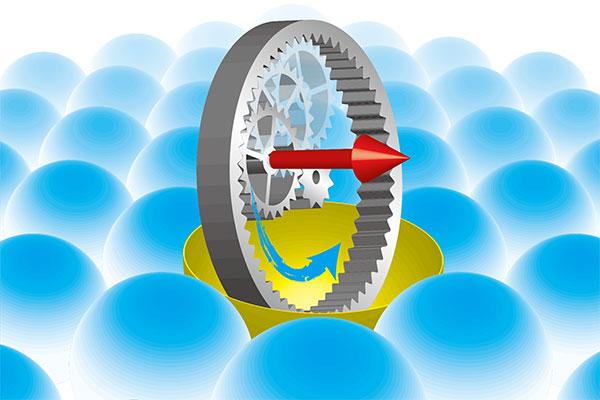New technology lets quantum bits hold information for 10,000 times longer than previous record

Conceptual art of the acceptor-based spin-orbit qubit. A boron atom (yellow) implanted in silicon crystal (blue) bounds a hole. Orbital motion of a hole in silicon is coupled to its spin degree of freedom. This cou-pling is reminiscent of gears where circular motion (blue arrow) and spinning (red arrow) are locked to-gether. Quantum information is encoded to the combined motion and spin of a hole in the spin-orbit qubit.
Credit: Takashi Kobayashi, Tohoku University
Usage Restrictions: News organizations may use or redistribute this image, with proper attribution, as part of news coverage of this paper only.
Quantum bits, or qubits, can hold quantum information much longer now thanks to efforts by an international research team. The researchers have increased the retention time, or coherence time, to 10 milliseconds – 10,000 times longer than the previous record – by combining the orbital motion and spinning inside an atom. Such a boost in information retention has major implications for information technology developments since the longer coherence time makes spin-orbit qubits the ideal candidate for building large quantum computers.
They published their results on July 20 in Nature Materials.
“We defined a spin-orbit qubit using a charged particle, which appears as a hole, trapped by an impurity atom in silicon crystal,” said lead author Dr. Takashi Kobayashi, research scientist at the University of New South Wales Sydney and assistant professor at Tohoku University. “Orbital motion and spinning of the hole are strongly coupled and locked together. This is reminiscent of a pair of meshing gears where circular motion and spinning are locked together.”
Qubits have been encoded with spin or orbital motion of a charged particle, producing different advantages that are highly demanded for building quantum computers. To utilize the advantages of qubits, Kobayashi and the team specifically used an exotic charged particle “hole” in silicon to define a qubit, since orbital motion and spin of holes in silicon are coupled together.
Spin-orbit qubits encoded by holes are particularly sensitive to electric fields, according to Kobayashi, which allows for more rapid control and benefits scaling up quantum computers. However, the qubits are affected by electrical noise, limiting their coherence time.
“In this work, we have engineered sensitivity to the electric field of our spin-orbit qubit by stretching the silicon crystal like a rubber band,” Kobayashi said. “This mechanical engineering of the spin-orbit qubit enables us to remarkably extend its coherence time, while still retaining moderate electrical sensitivity to control the spin-orbit qubit.”
Think of gears in a watch. Their individual spinning propels the entire mechanism to keep time. It is neither the spin nor orbital motion, but a combination of them that takes the information forward.
“These results open a pathway to develop new artificial quantum systems and to improve the functionality and scalability of spin-based quantum technologies,” Kobayashi said.
###
This work was supported in part by the ARC Centre of Excellence for Quantum Computation and Communication Technology, the U.S. Army Research Office and the Tohoku University Graduate Program in Spintronics.
Media Contact
All latest news from the category: Information Technology
Here you can find a summary of innovations in the fields of information and data processing and up-to-date developments on IT equipment and hardware.
This area covers topics such as IT services, IT architectures, IT management and telecommunications.
Newest articles

Parallel Paths: Understanding Malaria Resistance in Chimpanzees and Humans
The closest relatives of humans adapt genetically to habitats and infections Survival of the Fittest: Genetic Adaptations Uncovered in Chimpanzees Görlitz, 10.01.2025. Chimpanzees have genetic adaptations that help them survive…

You are What You Eat—Stanford Study Links Fiber to Anti-Cancer Gene Modulation
The Fiber Gap: A Growing Concern in American Diets Fiber is well known to be an important part of a healthy diet, yet less than 10% of Americans eat the minimum recommended…

Trust Your Gut—RNA-Protein Discovery for Better Immunity
HIRI researchers uncover control mechanisms of polysaccharide utilization in Bacteroides thetaiotaomicron. Researchers at the Helmholtz Institute for RNA-based Infection Research (HIRI) and the Julius-Maximilians-Universität (JMU) in Würzburg have identified a…



